
Do you have a question about the Philips Q552.1A and is the answer not in the manual?
Detailed technical specifications for product models, including hardware and software features.
Information on how to use the product, including website links for downloads.
Essential safety regulations and precautions to follow during repair and operation.
Important warnings regarding ESD, high voltage, and tool usage during service.
General notes and specific schematic notes, including measurement conditions and value interpretations.
Instructions for routing and securing cables for Matisse styling, showing diagram.
Instructions for routing and securing cables for da Vinci styling, showing diagram.
Step-by-step instructions for removing the rear cover and speakers of Matisse models.
Instructions for removing the rear cover and speakers for da Vinci styling models.
Guidance on measuring signals and using test patterns for diagnostics, specifying conditions.
Overview of service modes like SDM, SAM, and CSM, and the use of ComPair for diagnostics.
Explanation of stepwise start-up procedure for error detection and troubleshooting.
Explanation of the error code buffer, how errors are logged, and new error display methods.
Explanation of Layer 1 and Layer 2 error blinking procedures for remote diagnosis.
Overview of software and hardware protections, including supply errors and start-up protections.
Tips for fault finding, covering Ambilight, Audio Amplifier, CSM, DC/DC converters, and debugging.
Information on software upgrading for NAND Flash and main software, covering user and manual upgrades.
General conditions and settings required for performing electrical alignments, including power supply and warm-up.
Information on performing software alignments via SAM mode, covering white point, Ambilight, and TCON.
Introduction to option settings, explaining their purpose for microprocessor communication and diagnosis.
Procedure for resetting the NVM on a repaired SSB, including setting default values and virgin bit.
Introduction to the Q552.1A LA chassis, part of the TV550 platform, and its styling variations.
Explanation of the TV550 platform power architecture, referring to a diagram.
Description of the DC/DC converters and linear stabilizers used in the chassis, detailing their voltages and functions.
Description of the front-end for European/China region, including hybrid tuner and SoC processor.
Description of the HDMI multiplexer implementation, including ARC functionality and Sil9x87 specifications.
Description of the PNX85500 as the main audio/video processor, listing its features and capabilities.
Distinction between different backlight types like CCFL/EEFL and LED backlight, and their associated power boards.
Description of the 2-sided Ambilight implementation and architecture, referring to LED grouping.
Description of TCON application integrated on SSB, referring to TCON architecture.
Block diagram and pinning information for the USB Hub IC.
Block diagram and pin configuration for the Temperature Sensor and Headphone IC.
Block diagram and pin configuration for the PNX NandFlash and Conditional Access IC.
Block diagram and pin configuration for the Audio Amplifier IC.
Block diagram and pin configuration for the DC/DC Converter IC.
Block diagram and pin configuration for the DC/DC Converter IC.
Block diagram and pin configuration for the DC/DC Converter IC.
Block diagram and pin configuration for the Ethernet and Service IC.
Block diagram and pin configuration for the HDMI Switch IC.
Block diagram and pin configuration for the Headphone Amplifier IC.
Wiring diagram for the Matisse 42" model, showing connections between major components.
Wiring diagram for Matisse 46" - 52" models, detailing component connections.
Wiring diagram for Da Vinci 40" - 46" models, illustrating component interconnections.
Block diagram illustrating the video signal path and processing within the chassis.
Block diagram detailing the audio signal path, processing, and amplification stages.
Block diagram showing control signals and clock distribution across the chassis components.
Block diagram illustrating the I2C communication bus and connected components for diagnostics and control.
Overview of the power supply lines and their distribution to various modules and components.
Circuit diagram for AmbiLight Common LiteOn LED module, showing LED driver circuitry.
Circuit diagram for the 9 LED LiteOn module, detailing LED driver and control connections.
Circuit diagram for the 15 LED LiteOn module, showing LED driver and control circuitry.
Circuit diagram for the 21 LED LiteOn module, detailing LED driver and control connections.
Layout diagrams for AmbiLight LiteOn modules with varying LED counts (9, 12, 15, 18, 24, 30, 36 LEDs).
Circuit diagram for AmbiLight Common Everlight LED module, showing driver circuitry.
Circuit diagram for the 9 LED Everlight module, detailing driver and control connections.
Circuit diagram for the 15 LED Everlight module, showing driver and control circuitry.
Layout diagrams for AmbiLight Everlight modules with varying LED counts (18, 24, 30 LEDs).
Circuit diagram for the Common Interface module, covering Tuner, HDMI, and CI connections.
Circuit diagram for the Flash memory module, showing connections and IC details.
Circuit diagram for the USB Hub module, detailing its block diagram and pin configuration.
Circuit diagram for the SD Card interface module, showing connections and component details.
Circuit diagram for the PNX85500 Control module, illustrating its connections and functions.
Circuit diagram for the HDMI & CI module, detailing tuner, audio interfaces, and signal processing.
Circuit diagram for the Toshiba Supply module, showing power conversion circuits.
Circuit diagram for the HDMI connector side, detailing pin assignments and signal paths.
Circuit diagram for the VGA connector, showing signal paths and associated components.
Circuit diagram for the Temp Sensor and Headphone module, showing connections to the amplifier.
Circuit diagram for the Tuner module specific to the Brazil region, showing RF and digital tuning components.
Circuit diagram for the PNX NandFlash and Conditional Access module, detailing memory and processor connections.
Circuit diagram for the PNX SDRAM module, illustrating memory chip connections and power supplies.
Circuit diagram for the PNX Digital Video In module, showing HDMI and analog video inputs.
Circuit diagram for the PNX Audio module, detailing signal processing and amplification circuits.
Circuit diagram for the PNX MIPS controller, showing its interfaces to Ethernet, USB, and other peripherals.
Circuit diagram for the PNX Video Out module, illustrating LVDS signal transmission to the display panel.
Circuit diagram for the PNX Stand-by Controller, showing its control interfaces and signals.
Circuit diagram for the PNX Power module, detailing various voltage regulators and power distribution.
Circuit diagram for the PNX Analog Video module, showing analog input and processing circuits.
Circuit diagram for the Audio module, including Class D amplifier, speaker connections, and headphone output.
Circuit diagram for the DC/DC converter module, showing voltage regulation circuits.
Circuit diagram for the DC/DC converter module, detailing power management and voltage regulation.
Circuit diagram for the DC/DC converter module, illustrating power distribution and regulation for various components.
Circuit diagram for the DC/DC converter module, showing voltage regulators and their connections.
Circuit diagram for the Temperature Sensor and Ambilight interface module, showing sensor and LED connections.
Circuit diagram for the Fan Control module, detailing fan speed control and temperature sensing interfaces.
Circuit diagram for the Vdisp Switch module, illustrating power switching and control logic.
Circuit diagram for the Analogue Externals A module, detailing input/output connectors and signal conditioning.
Circuit diagram for the Analogue Externals B module, showing SVHS, YPbPr, and VGA connections.
Circuit diagram for the Ethernet and Service interface module, detailing network and diagnostic connections.
Circuit diagram for the HDMI connectors, showing pin assignments and I2C communication for EDID and CEC.
Circuit diagram for the Headphone module, showing amplifier and connector details.
Circuit diagram for the DDR SDRAM modules, illustrating memory chip connections and layout.
Circuit diagram for the Display Interfacing module, showing LVDS connections for VDisp.
Circuit diagram for the Video Out module, illustrating LVDS signal transmission to the display.
Circuit diagram for the Ambilight CPLD module, showing SPI communication and control signals.
Circuit diagram for the SPI Buffer module, detailing its buffer logic and connections.
Circuit diagram for the Non DVBS Connector Board, showing connections for Hotel TV, sensors, and LED panel.
Circuit diagram for the AmbiLight CPLD module, illustrating SPI communication and control for Ambilight LEDs.
Circuit diagram for the TCON Control module, showing Gamma, VCom, and Flash connections.
Circuit diagram for the TCON DC/DC converter module, detailing voltage regulation for the TCON.
Circuit diagram for P Gamma, VCom, and Flash components on the TCON module.
Circuit diagram for the MPD module, showing its connections to the display and various control signals.
Circuit diagram for the Mini LVDS interface, showing LVDS signal paths and connections.
Circuit diagram for various connectors, showing dummy testlands, LED panel, temperature sensor, and hotel TV connections.
Styling details for Matisse models, listing part numbers and descriptions for external components.
Styling details for Da Vinci models, listing part numbers and descriptions for external components.


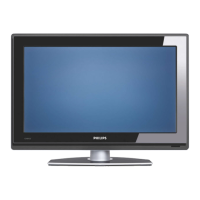


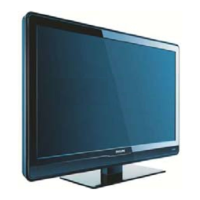

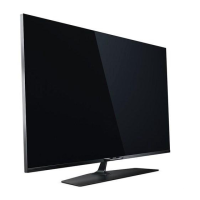

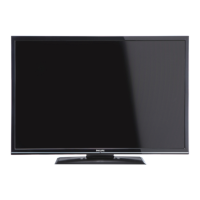
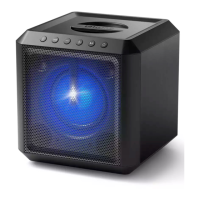

